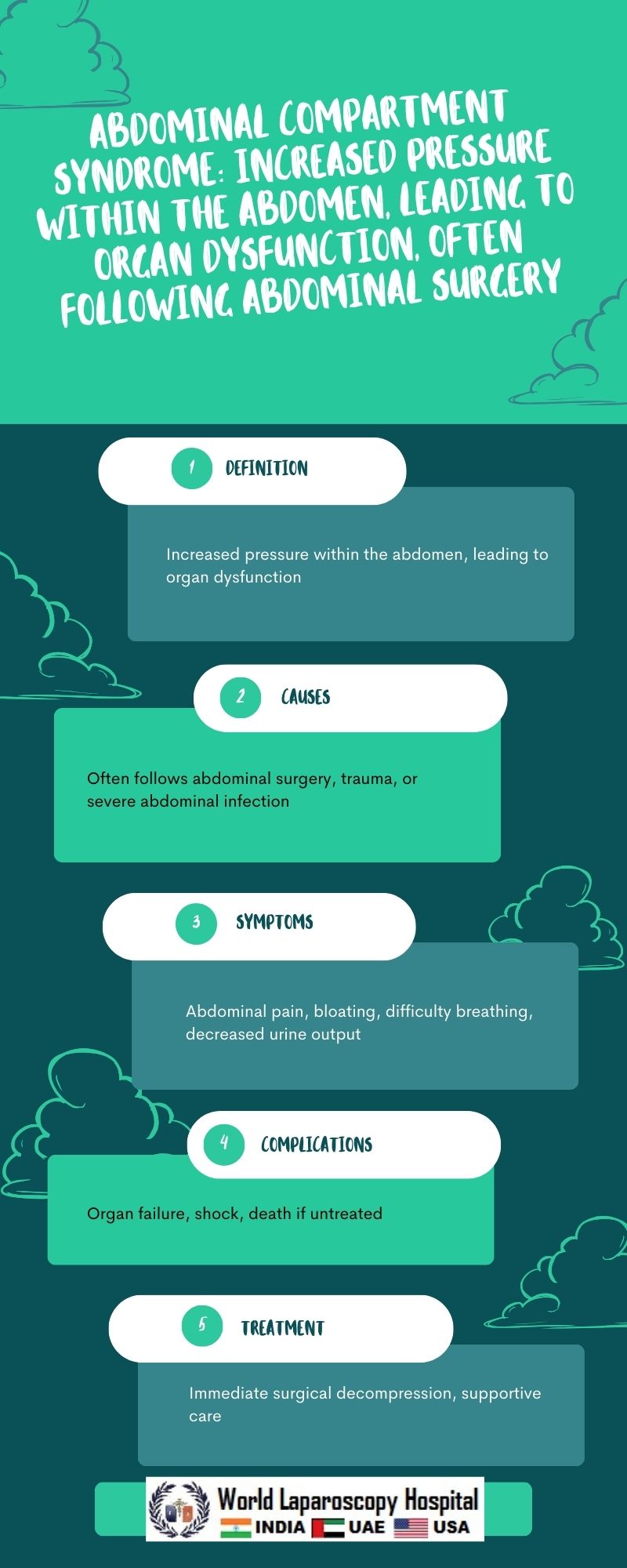Abdominal compartment syndrome: Increased pressure within the abdomen, leading to organ dysfunction, often following abdominal surgery
Introduction
Abdominal compartment syndrome (ACS) is a serious condition characterized by increased intra-abdominal pressure (IAP) leading to organ dysfunction. It typically occurs following abdominal surgery but can also result from trauma, pancreatitis, or other abdominal pathologies. This review aims to provide a comprehensive overview of ACS, including its pathophysiology, clinical presentation, diagnosis, and management.

Pathophysiology
The pathophysiology of ACS revolves around the concept of the intra-abdominal pressure-volume relationship. The abdomen is a closed compartment bounded by the abdominal wall, diaphragm, and spine. It contains several organs, including the liver, spleen, stomach, intestines, and kidneys, as well as large blood vessels and lymphatics. Under normal circumstances, the IAP is relatively low, around 5-7 mmHg, and is maintained by the balance between the volume of abdominal contents and the compliance of the abdominal wall.
In ACS, this balance is disrupted, leading to an increase in IAP. This can occur due to several factors, including:
- Increased abdominal contents: such as in cases of bowel edema, hemorrhage, or ascites.
- Decreased abdominal wall compliance: as seen in abdominal surgery, trauma, or burns.
- Inflammatory response: such as in pancreatitis or peritonitis, leading to fluid accumulation and edema.
- Vascular congestion: due to conditions like venous thrombosis or congestive heart failure, causing increased capillary permeability and fluid leakage into the abdomen.
As the IAP rises, it can compress the abdominal organs and compromise blood flow to vital organs, leading to ischemia and organ dysfunction. The consequences of ACS can be systemic, affecting multiple organ systems, including the cardiovascular, respiratory, renal, and gastrointestinal systems.
Clinical Presentation
The clinical presentation of ACS can vary depending on the severity and duration of the condition. Early signs and symptoms may include abdominal distention, increased ventilator requirements, and oliguria. As the condition progresses, patients may develop hypotension, tachycardia, respiratory distress, and altered mental status. Physical examination may reveal tense abdominal distention, decreased bowel sounds, and signs of organ dysfunction.
Diagnosis
The diagnosis of ACS is based on a combination of clinical findings and measurement of intra-abdominal pressure. The World Society of Abdominal Compartment Syndrome (WSACS) defines ACS as a sustained IAP greater than 20 mmHg associated with new organ dysfunction or failure. Several methods can be used to measure IAP, including intra-vesicular pressure measurement, intragastric pressure measurement, and direct measurement of intra-abdominal pressure.
Imaging studies such as ultrasound or CT scan may also be useful in assessing for signs of organ dysfunction or complications of ACS, such as bowel ischemia or abdominal compartment syndrome.
Management
The management of ACS involves a multidisciplinary approach aimed at reducing intra-abdominal pressure, improving organ perfusion, and addressing the underlying cause. Initial management includes optimizing fluid resuscitation, pain control, and ventilator management. In cases where these measures are insufficient, surgical decompression may be necessary.
Surgical decompression can be achieved through various techniques, including laparostomy, subcutaneous fasciotomy, or decompressive laparotomy. These procedures aim to relieve the pressure within the abdomen, improve organ perfusion, and prevent further organ dysfunction. However, surgical decompression is not without risks and should be carefully considered in each individual case.
Conclusion
Abdominal compartment syndrome is a serious condition that can occur following abdominal surgery, trauma, or other abdominal pathologies. It is characterized by increased intra-abdominal pressure leading to organ dysfunction. Early recognition and prompt management are essential to improve outcomes. A multidisciplinary approach involving surgeons, intensivists, and other specialists is crucial in the management of ACS. Further research is needed to better understand the pathophysiology and optimal management strategies for this complex condition.